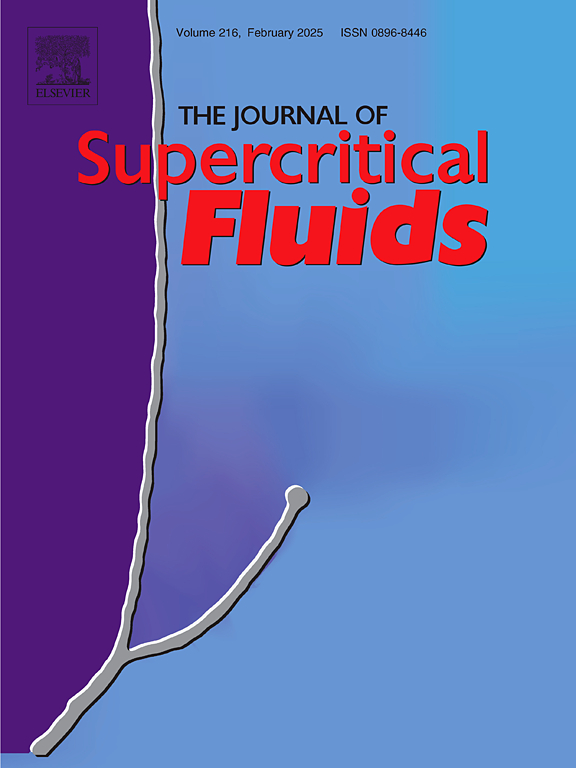Supercritical CO2 extraction of bioactives from P. halepensis petals: Process modeling, mass transfer, and bioactivity characterization
IF 4.4
3区 工程技术
Q2 CHEMISTRY, PHYSICAL
引用次数: 0
Abstract
The extraction of bioactive compounds from P. halepensis petals was carried out using supercritical carbon dioxide (Sc-CO2) under varying operational conditions, including extraction time, pressure (300–500 bar), co-solvent type (water or ethanol), and particle size (120–1400 µm), and compared to conventional techniques such as Soxhlet extraction and maceration. The results showed that Sc-CO2 extraction at 300–500 bar achieves ∼80 % recovery of bioactive compounds within the first 30 min. Tan, Liang and Liou model successfully fitted the extraction kinetics. Furthermore, all extracts demonstrated moderate to high anticancer activity against LS174t and HCT116 cell lines compared to tamoxifen (a well-known anticancer standard). Extracts obtained by Sc-CO2 with water as a co-solvent exhibited significant antioxidant activity against DPPH free radical; however, their antioxidant activities were notably lower than those obtained through conventional extraction methods. Finally, 38 molecules were identified by HPLC-DAD and 24 by GC-MS. The originality and novelty of this study are a) First-time application of Sc-CO2 to extract bioactive compounds from P. halepensis petals; b) Identification of new chemical compounds (seven detected for the first time in this species) as a novel contribution.
从halepensis花瓣中提取生物活性的超临界CO2:过程建模、传质和生物活性表征
利用超临界二氧化碳(Sc-CO2)在不同的操作条件下,包括提取时间、压力(300-500 bar)、助溶剂类型(水或乙醇)和粒径(120-1400 µm),并与索氏提取和浸渍等传统技术进行比较。结果表明,300-500 bar的Sc-CO2萃取在前30 min内,生物活性化合物的回收率达到~ 80 %。Tan, Liang和Liou模型成功拟合了萃取动力学。此外,与他莫昔芬(一种著名的抗癌标准)相比,所有提取物对LS174t和HCT116细胞系显示出中等至高的抗癌活性。以水为共溶剂的Sc-CO2提取液对DPPH自由基具有明显的抗氧化活性;但其抗氧化活性明显低于常规提取方法。HPLC-DAD鉴定38个分子,GC-MS鉴定24个分子。本研究的原创性和新颖性在于:a)首次将Sc-CO2应用于紫菜花瓣中生物活性物质的提取;b)发现新的化合物(其中7个为首次在该物种中发现)。
本文章由计算机程序翻译,如有差异,请以英文原文为准。
求助全文
约1分钟内获得全文
求助全文
来源期刊

Journal of Supercritical Fluids
工程技术-工程:化工
CiteScore
7.60
自引率
10.30%
发文量
236
审稿时长
56 days
期刊介绍:
The Journal of Supercritical Fluids is an international journal devoted to the fundamental and applied aspects of supercritical fluids and processes. Its aim is to provide a focused platform for academic and industrial researchers to report their findings and to have ready access to the advances in this rapidly growing field. Its coverage is multidisciplinary and includes both basic and applied topics.
Thermodynamics and phase equilibria, reaction kinetics and rate processes, thermal and transport properties, and all topics related to processing such as separations (extraction, fractionation, purification, chromatography) nucleation and impregnation are within the scope. Accounts of specific engineering applications such as those encountered in food, fuel, natural products, minerals, pharmaceuticals and polymer industries are included. Topics related to high pressure equipment design, analytical techniques, sensors, and process control methodologies are also within the scope of the journal.
 求助内容:
求助内容: 应助结果提醒方式:
应助结果提醒方式:


